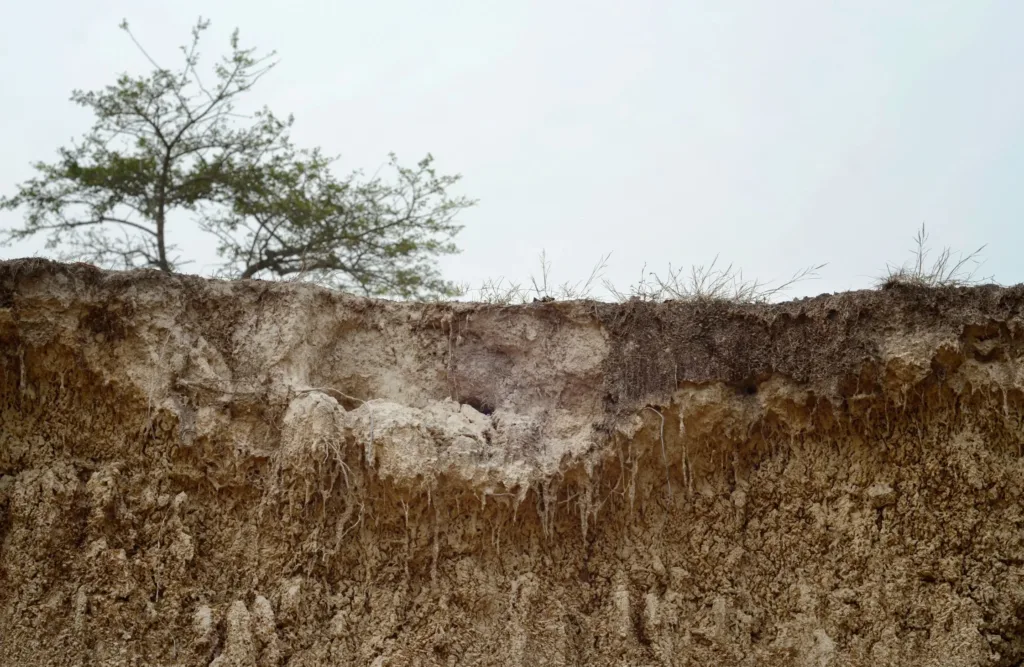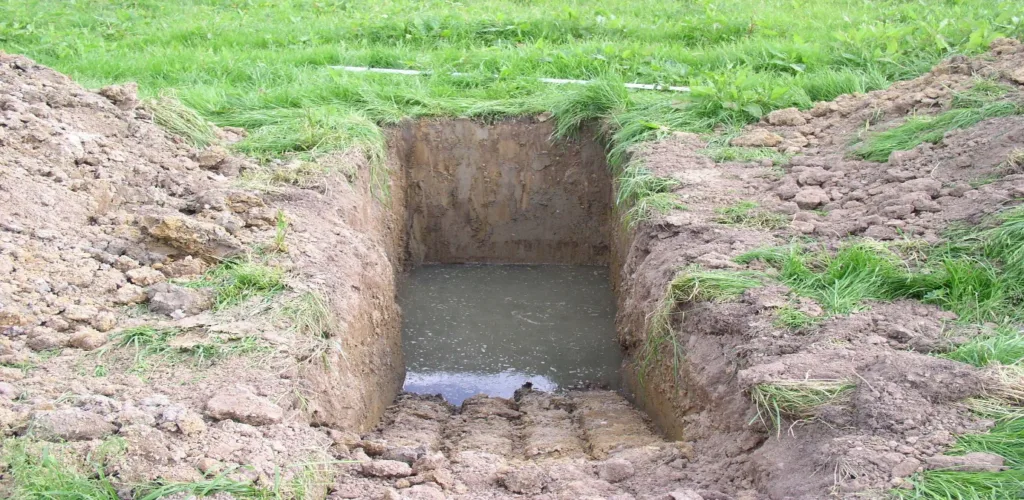Ground-bearing rafts are large concrete slabs, connected directly with the ground below, and offer economic, operational and environmental benefits compared to piling operations when suitable.
As with all construction choices, they come with their own set of considerations, notably the challenge of potential settlement. In this article we discuss the intricacies, suitability and benefits of ground-bearing rafts as a foundation choice.

Ground bearing rafts on site
Potential Uses of Ground-Bearing Raft Foundations
1. Sites with Soft or Variable Shallow Soils
In locations where the top layer of soil is either too soft or inconsistent in its composition, traditional foundation methods might not be appropriate.
While piling could be a solution, it becomes impractical in situations where there’s a hard bedrock layer just below the surface. Ground-bearing rafts distribute the structural load evenly across the soft or uneven soil above the hard bedrock.
2. Sites with Limited Dissolution Risk
Dissolution refers to the process where certain bedrocks, like chalk, dissolve due to the action of water. In areas with shallow bedrock like chalk, there is the potential risk of the ground sinking or forming sinkholes, meaning Ground-bearing rafts can spread the load and reduce point pressures where there is limited chalk dissolution
3. Sites Utilising Significant Engineered Fill
When large amounts of engineered fill are used to raise the ground level or replace unsuitable natural soils, ground-bearing rafts can be an optimal choice. They provide a stable base atop this fill, ensuring the weight of the structure is evenly distributed.
Performance of the raft is related to the quality of the engineered fill so it should be ensured that filling is carried out using good quality materials and using the correct compaction methods.
4. Sites with Shallow Groundwater
In areas where groundwater is close to the surface, traditional foundation methods might face challenges due to water intrusion, excavation instability or soil weakening. Ground-bearing rafts, with their wide base and use of granular infill, offer a resilient solution, ensuring the foundation remains unaffected by the shallow water table.
How Ground-Bearing Rafts Work
Ground-bearing rafts combine the best of geotechnical engineering with innovative design to ensure stability and longevity. However, they require a comprehensive geotechnical investigation and careful design considerations to ensure they function effectively:
Comprehensive Geotechnical Investigation
A thorough geotechnical site investigation maps out the soil’s composition, strength, and other characteristics, to understand the ground beneath. This assessment foresees potential groundworks challenges, ensuring that any proposed designs for the scheme will safely bear the building’s weight.

A detailed geotechnical investigation map
The Role of the Granular Mattress
While it’s possible to place rafts directly on natural ground, most scenarios call for a granular mattress, which sits below the raft. Think of this as a buffer or cushion. This layer serves to evenly distribute the loads, ensuring consistent weight distribution and reducing the risk of uneven settlement.
SPEEDECK’s Advanced Approach
SPEEDECK incorporates cutting-edge design and engineering techniques that often result in a simplified construction program. By leveraging advanced tools like T-value analysis and the latest in modern reinforcement methods, SPEEDECK’s schemes provide a strengthened granular layer with a reduced thickness, translating to cost and time savings for the project.
The Power of Geogrid
A Geogrid is like a sturdy mesh, used underground to reinforce and stabilise the soil. By incorporating geogrid reinforcement in the granular layer above clay soil, the bearing capacity is boosted substantially. This innovation offers a more nuanced and effective way to design and construct granular layers.

Geogrid reinforcement at a construction site
Benefits of this approach
- Robustness: The geogrid amplifies the strength of the granular layer. This reinforcement ensures the layer remains intact, even under substantial load, preventing any “punch-through” scenarios.
- Economic Efficiency: Strengthening the granular layer with geogrid means lesser material is required to achieve the same strength. This leads to cost savings not only in material but also in transportation and labour. Moreover, a more streamlined mattress design curtails the need for muck-away and the import of additional fill.
- Optimal Load Distribution: The geogrid ensures that the weight from the structure is disseminated uniformly across the granular layer. This even spread minimises pressure points, mitigating the risk of localised failures.
Advantages of Ground Bearing Rafts
Ground bearing rafts offer a range of economic, operational, and environmental advantages, with the Geogrid achieving cost savings through the reduction of material usage.
The use of raft foundations can utilise existing soil to mitigate the depletion of natural resources, reduce the carbon footprint, and minimise the impact on the surrounding environment. Ground bearing rafts can also offer thermal mass benefits and optimise soil usage, thus leading to energy-efficient building operations.

Construction sites are more efficient – they require fewer people, produce less waste, and reduce overall disruption in the area
Economic Benefits
- Cost Savings: Deep foundations are often an appropriate solution but can be expensive, particularly if not the optimal solution for a given site, thanks to extensive excavation, material needs, and prolonged construction timelines. Ground bearing rafts, in contrast, can be a more cost-friendly alternative that doesn’t compromise on quality.
- Time Efficiency: Time is money, and ground bearing rafts are synonymous with faster construction. This translates to reduced labour costs and expedited project timelines.
Operational Benefits
- Uniform Load Distribution: One of the standout features of ground bearing rafts is their capability to distribute weight evenly. This minimises the chances of localised settlement, saving potential expenses on structural repairs.
- Energy Efficiency: A stable foundation can significantly boost a building’s energy efficiency. This not only means a comfortable interior but also reduced energy bills.
- Minimised Noise and Vibration: Especially beneficial in urban settings, the construction of ground bearing rafts ensures reduced noise and vibration, helping maintain a peaceful surrounding environment during construction.
- Reduced Risk of Heave: These rafts are designed to minimise the effects of soil moisture-induced heave. However if heave challenges are too significant then ground bearing rafts won’t be ideal.
Environmental Benefits:
- Reduced Excavation: Ground bearing rafts require minimal excavation, leading to less soil disturbance and a reduced carbon footprint.
- Conservation of Resources: Ground bearing rafts are material-efficient, conserving costly resources like concrete and steel.
- Lower Energy Consumption: An energy-friendly construction process reduces environmental impact.
- Minimised Groundwater Disruption: Their shallow nature ensures that ground bearing rafts don’t disrupt the groundwater flow, preserving the local water table.
- Use of Sustainable Materials: Modern ground bearing rafts can incorporate eco-friendly materials, promoting green construction.
- Thermal Mass Benefits: Their design offers thermal regulation, reducing energy needs for heating and cooling.
- Flexibility for Land Reuse: Their presence ensures that the land remains largely reusable, reducing remediation needs in the future.
- Reduced Transportation Impact: Fewer materials and waste mean fewer transportation needs, resulting in reduced emissions and traffic disturbances.
- Optimal Soil Usage: They capitalise on the existing soil, reducing the need for additional fill materials.
- Mitigation of Contamination Risks: In areas prone to soil contamination, ground bearing rafts can be a safer alternative to deeper foundations.
The Speedeck Success Story:
To bring these benefits to life, consider recent successful projects by Speedeck. Speedeck have in the past few years installed ground bearing rafts on several sites across the Home Counties, primarily to address chalk dissolution risk where other foundation solutions were uneconomical or not possible. The use of ground bearing rafts allowed the building foundations to span across potential small soft spots or voids without impacting settlement performance. This was achieved for a lower cost than would have been involved with reinforced strip foundations.
When are Ground Bearing Raft Foundations not Suitable?
Although advantageous in many scenarios, Ground bearing raft foundations may not be the best choice under specific circumstances. It’s essential to understand these conditions to make informed decisions early in the construction process.
Heave Challenges
Ground bearing rafts might not be the most economical choice in areas where heave is a significant concern. Soil heave, which refers to the upward movement of the ground, is typically caused by the expansion of clay soils when they get wet. This can exert pressure on the foundation, leading to potential structural issues and movement of the structure.

Heave risk for various species of tree
In situations where heave is anticipated, the construction of ground bearing rafts would necessitate a thick granular mattress to be placed beneath the raft to mitigate the effects of the heave.
As per NHBC guidelines, the depth of this infill should be at least 50% of the required foundation depth and not more than 1.25m (measured from ground level). The extent should also go beyond the edge of the foundation by a distance equal to its natural angle of repose, plus an additional 0.5m. Such requirements can escalate the costs significantly.
Other Foundation Options
In some scenarios, other foundation types such as deep strips or piles might be more suitable. These options can be especially beneficial in sites with significant variations in soil conditions or where there’s a need to bypass weak soil layers and transfer loads to stronger, deeper layers.
Ground bearing rafts might only be considered in situations where heave is a concern if other foundation methods are impractical or not possible. For instance, there might be challenges with deep strips or piles due to hard bedrock, limiting access for drilling equipment, or other site-specific constraints.
As with any building project, it’s important to carefully evaluate all options and consider the specific conditions of the site. By introducing geotechnical engineers early on in the process, the most effective foundation scheme for the ground conditions of the site can be determined.
Conclusion
Ground bearing raft foundations, with their benefits, are a compelling choice, however, like with every engineering project, they are not a one-size-fits-all solution.
The key lies in thorough assessment, understanding the nuances of the site, and employing the most fitting foundation strategy.
As demonstrated by SPEEDECK’s successes, when employed judiciously, ground bearing rafts can deliver both economic and environmental advantages.
Interested in exploring the benefits of ground bearing rafts for your project? Get in touch with us today.

Completed housing constructed on a SPEEDECK foundation




